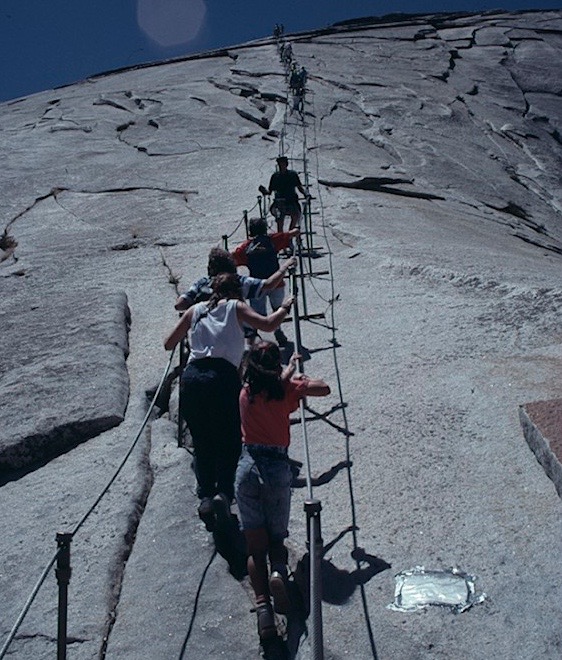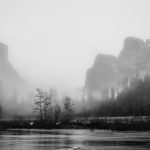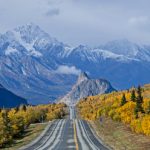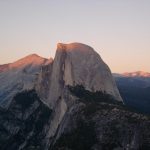The plastic water bottle skidded off the granite and disappeared. It wasn’t the sound the bottle made that disturbed me. It was the silence that followed its rapid disappearance.
Along with twenty to twenty-five other people I was perched on the east face of Half Dome in Yosemite National Park, the world-famous granite slab that John Muir called “the most beautiful and most sublime of all the wonderful Yosemite rocks.” We were climbing the cables that lead up the backside to its 8,842-foot summit. The message in the bottle needed no translation. It was as clear as the pale blue sky above us.
Hug the cables tight, and we’d all be fine. They meant safe passage up and down. My problem was that I was feeling woozy and lightheaded, unsure if I should—or could—take another step upward.

Mounting the Cables
The cables ascend a 46-degree vertical slope that constitutes the last 400 feet of the climb. Every five feet or so feet there are poles and wood 2x4s driven into the rock that allow you to sit down, and rest, while maintaining close contact with the steel cables (which can be hard on the hands; many climbers use gloves). Without the cables, anyone not named Alex Honnold would be severely challenged to make it up the glacier-polished rock that in places is as smooth as a windowpane. But even with the fixed support it’s scary to be hanging off a wall that high and that steep.
On this summer’s day, four buddies and I were hoping to duplicate the feat that Muir himself first did, in 1875. The irrepressible naturalist and mountaineer cannot claim Half Dome’s first ascent, however; that honor belongs to a Scottish carpenter named George Anderson, who did it that same year with the aid of iron spikes he drilled into the wall. Things have certainly changed since pioneer days. Like Everest or Kilimanjaro, Half Dome has become a global climbing magnet for “peak-baggers,” and on the worst days the hordes of people thronging the cables resembled a TSA line at the airport.
Too much love was spoiling the experience of climbing Half Dome and so, at the start of the decade, the National Park Service instituted a permitting system designed to curb the crowds and promote safety. (Some hikers have died while making the attempt.) Nowadays a maximum of 300 people a day are allowed to climb Half Dome during the peak summer months, and all who do so—day hikers as well as backpackers—must have a permit. Preseason and daily lotteries are held to determine who receives the permits.
The Allure of Half Dome
The rock’s most obvious allure is its spectacular beauty. It is a massive yet graceful monolith that anchors the southern end of a valley filled with many other spectacular beauties. The Miwok Indians called it “Tissaack,” a reference in tribal lore to the princess who cried tears of despair over her fallen lover. The wide black streaks on the northwest face symbolically represent those tears. Of all the millions of photographs taken of it over the years, the best one remains one of the earliest, a 1927 image, “Monolith, The Face of Half Dome,” shot by a young Ansel Adams using a Korona view camera.

Another big reason for its popularity is its relative accessibility. You don’t need oxygen tanks or Sherpas carrying your stuff to make it to the top. Nevertheless it’s not a thing to be taken lightly. For most people the climb begins in Happy Isles in Yosemite Valley at about 4,000 feet above sea level. They cross the Vernal Fall bridge and climb up the steep steps of the Mist Trail below Nevada Fall before coming into Little Yosemite Valley and beginning the long push to the top. The approximately 16-mile round-trip consists of 4,800 feet up, 4,800 feet down; it’s frequently done in a day, with summiteers starting out in the early morning and not returning to the valley floor until late afternoon or evening.
Watch Out for that Sun!
As you climb the switchbacks upward you can find pockets of respite among the trees. Sit down, take a break, sip some water, chow down an energy bar. But when I finally cleared the tree line and said goodbye to that blessed shade, the sun, a dazzling hot ball of fire surrounded by blueness, nearly knocked me off my feet. I felt like I had walked into an open-air furnace.
Was someone hitting me in the head with a hammer? It felt like it, despite my cap. My throat was parched, my forehead and cheeks clammy with dried sweat. After working hard for hours I felt suddenly robbed of all energy. I had summited Half Dome twice before, so I should have known better. But I had pushed too hard in the early stages, not pacing myself, practically running to get ahead of a group of slowpokes who were clogging the trail ahead of us. This wasted energy needlessly.
Another major miscalculation was that I failed to consider the area known as the Sub Dome, the steep, mostly treeless granite hump that precedes Half Dome. It is, in my view, the hardest part of the climb. The switchbacks are brutal, and there’s no hiding from that scorching sun. It would have been better for me to have lunch and store up my energy before attempting this section, except that my friends and I had all agreed to eat together on the summit. I wanted to hold up my part of the bargain.

Deciding to Go Back Down
When I finally reached the cables, I was a mess. My friend Dan urged me on, saying to just keep putting one foot in front of the other and that I could make it. He even tried pushing me from below as I hung tightly to the cables and climbed up, grabbing for breath in the thin air, in a kind of daze, my stomach churning.
That was the moment the water bottle slid off into oblivion, and that settled it. I was done. As Dan went off to keep his lunch date with the others I climbed off the cables and headed down the Sub Dome. Sometimes the best remedy when you’re not feeling well on a mountain is to simply go back down it.
We all reunited at the Nevada Fall Bridge. Dan and the three others who reached the top were rightly stoked by what they had done. Oddly perhaps, so was I. While disappointed at not making the summit, I felt good that I had made the right decision to turn back, given the circumstances. Lower down on the mountain, my strength had returned and I was thinking clearly again.
So, okay, I didn’t make it to the top. Not that time. But Half Dome isn’t going anywhere. I’ll be back.
Photographs courtesy of National Park Service (1), and Rob Floerke (2,3).
Useful Links





You are always learning as a writer and although I’ve hiked and backpacked Yosemite for years, I’m still learning about it. In the article I say that the Miwoks were the ones who originated the story of Tis-sa-ack and Half Dome. Not true. It was the tribe that originally settled there, the Yosemites, or perhaps their ancestors that preceded them, the Ahwanees. There are many variations on the Tis-sa-ack story. Perhaps, in a future piece, I’ll tell another, very interesting one.
Wonderful article; thanks for sharing the wisdom of a great decision—even if it wasn’t what was desired.
Great article Kevin – with a wise lesson. Nice photos!
I hear there is a lottery or permit system now – we climbed the backside a number of years ago, it was free for all at that time. Although the grueling hike just to reach the base ending up being a barrier to climbing the dome for quite a few people .
Thanks, all, for your comments. There are indeed restrictions on how many people can go up in a day, and it’s probably a good thing. It’s awful to see too many people attacking such a beautiful dome at the same time, like ants overwhelming a picnic.